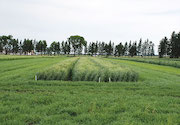| |
| |
 |
 |
| |
 |
|
@{mv_date_MMM d, yyyy}@ |
|
| |
The investment of up to $4.4 million over two years will support Cereals Canada, Canada Grains Council, and the Prairie Oat Growers Association in their efforts to grow Canada’s grain exports.
» Read more...
Topics covered include the Next Agricultural Policy Framework (the successor to CAP), climate change, global food supplies and input availability, and how global events and supply chain disruptions are affecting Canadian agriculture.
» Read more...
The Sustainable Agriculture and Food Security pillar focuses on helping youth leaders explore sustainable farming practices, agricultural career paths and food security at home and abroad.
» Read more...
|
| |
|
| |

You can’t rely on luck of the draw to keep your cereals Fusarium-free this season, but you can make sure your crop comes up aces with best-in-class protection.
Miravis ® Ace fungicide from Syngenta is effective on all significant Fusarium species, as well as ergot and various leaf diseases. It delivers strong preventative and long-lasting activity resulting in lower DON levels, higher grain quality and improved yields.
New for 2022: Miravis ® Ace is now registered for use in barley and oats, as well as spring, winter, and durum wheat.
» Learn more... |
| |
|
| |
 Fusarium head blight is caused by a species complex; the particular species dominating the complex can be really important. For instance, different species can be favoured by different growing conditions, cause different symptoms, respond differently to control measures, and produce different toxins with different implications for end-uses. These days, Fusarium poae is a growing concern on the Prairies.
» Learn more...
Fusarium head blight is caused by a species complex; the particular species dominating the complex can be really important. For instance, different species can be favoured by different growing conditions, cause different symptoms, respond differently to control measures, and produce different toxins with different implications for end-uses. These days, Fusarium poae is a growing concern on the Prairies.
» Learn more... |
| |
 Copidosoma bakeri is a species of parasitoid wasp that parasitizes cutworms by laying an egg inside a cutworm’s egg. The wasp’s egg clones itself 100 or more times inside its host, producing larvae that eat from the inside the caterpillar. But what are the best ways to deliberately deploy parasitoid wasps as a biocontrol measure against crop pests?
» Learn more...
Copidosoma bakeri is a species of parasitoid wasp that parasitizes cutworms by laying an egg inside a cutworm’s egg. The wasp’s egg clones itself 100 or more times inside its host, producing larvae that eat from the inside the caterpillar. But what are the best ways to deliberately deploy parasitoid wasps as a biocontrol measure against crop pests?
» Learn more... |
| |
|
| |
|
|
| |
| |





